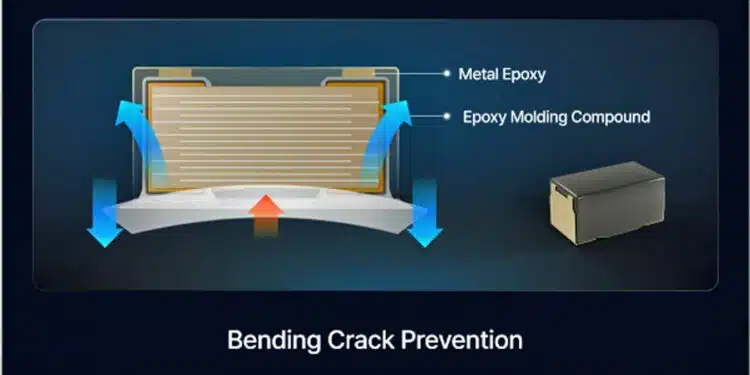Samsung Electro-Mechanics introduces molded frame MLCC capacitor (MFC) to enhance reliability and efficiency of MLCC ceramic capacitors in high-power environments.
Samsung Electro-Mechanics announces the launch of its Molded Frame Capacitor (MFC), designed to address the limitations of traditional Multi-Layer Ceramic Capacitors (MLCCs).
Leveraging advanced metal frame and molding technologies, the MFC offers superior durability, reduced noise, and enhanced environmental resistance.
Overcoming MLCC Challenges with Innovative MFC Design
MLCCs have long been valued for their high capacitance in compact sizes, offering exceptional reliability and longevity. However, vulnerabilities to moisture, cracking from external stresses, and noise issues due to piezoelectric effects have posed significant challenges. Samsung Electro-Mechanics’ MFC directly tackles these concerns:
- Crack Prevention: The metal frame structure of the MFC mitigates risks associated with PCB bending stress, a common cause of MLCC cracking.
- Noise Reduction: Integrated moldings around the metal frame effectively minimize vibrations caused by the piezoelectric effect, significantly reducing acoustic noise on PCB surfaces.
- Environmental Resistance: The robust molding enhances tolerance to humidity, dust, and external impacts, ensuring sustained reliability even in harsh, remote environments.
Optimized for the Growing 48V Power Market
As AI data centers and uninterruptible power supply (UPS) markets expand, the demand for efficient power solutions rises. Traditional 12V power lines face challenges like current loss and heat generation under high-power conditions. Samsung Electro-Mechanics addresses this with its 100V MFC line-up, specifically engineered for 48V environments, offering:
- Greater energy efficiency
- Higher power density
- Enhanced performance in demanding applications
| Samsung | Size(inch/mm) | Capacitance | TCC | RelatedVoltage | Sample |
|---|---|---|---|---|---|
| CL32B225KCDMNW# | 1210/3225 | 2.2㎌ | X7R | 100Vdc | Available |
| CL32Y475KCDMNW# | 1210/3225 | 4.7㎌ | X7S | 100Vdc | Available |






























